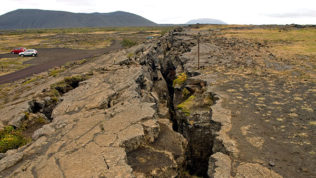Imagine sitting down for a delicious meal with your family. You’re about to enjoy your first bite when you hear what sounds like a motorcycle passing in your backyard. You feel your body tremble and shake and realize what you heard was not a motorcycle, but the earth cracking beneath you. How do you keep you and your family safe? What should you do?
Although certain areas are more susceptible to earthquakes than others, no matter where you reside, prepare your family to take the appropriate actions. Earthquakes come without notice and can happen while you are at home, at work or traveling.
WHILE THE EARTH IS SHAKING
Once the ground starts to shake, three actions are essential:
- DROP: Stay where you are and drop to your hands and knees. Do not go outside during the shaking as exterior walls of a building are the most susceptible to damage. Falling debris such as exterior masonry or windows could present a danger.
- COVER: Cover your head and neck with your arms. Stay on your knees or bent over to protect vital organs.
- If a sturdy table or desk is nearby, crawl under it for shelter.
- If no shelter is nearby, crawl toward the interior of the building. Stay away from windows and other hazards. Crawl to a safer location only if nearby areas are free from debris or other hazards; usually it’s safer to stay where you are.
- HOLD ON: Hold on until the shaking stops.
- Under shelter: If you are under shelter, hold on to the shelter with one hand and be ready to move with it if it moves.
- No shelter: Hold your head and neck with both arms and hands. If you are outside, find a place away from power lines, buildings or trees.
- Driving a vehicle: Pull over and stop. Set your parking brake.
- Coastal: Earthquakes frequently cause tsunamis; seek higher ground as soon as it is safe to do so.
AFTER AN EARTHQUAKE
Additional dangers follow an earthquake, including falling debris, leaking gas and water lines or downed power lines.
- If your building is damaged, go outside and move away as quickly as possible. Do not enter any damaged buildings.
- If you are trapped, protect your mouth, nose and eyes from dust. Send a text message or make loud noises using items around you – instead of shouting – to help rescuers locate you.
- Be prepared for aftershocks.
Taking the appropriate actions can save lives and reduce the risk of injury. Throughout the year remember Drop, Cover, Hold On and practice regularly.
International ShakeOut Day is always the third Thursday of October. Consider joining people around the world in this event by practicing emergency measures or scheduling a drill. To learn more visit https://www.shakeout.org/california/.
Learn more about how to become personally prepared during an earthquake at https://www.ready.gov/earthquakes.
This loss control information is advisory only. The author assumes no responsibility for management or control of loss control activities. Not all exposures are identified in this article.

